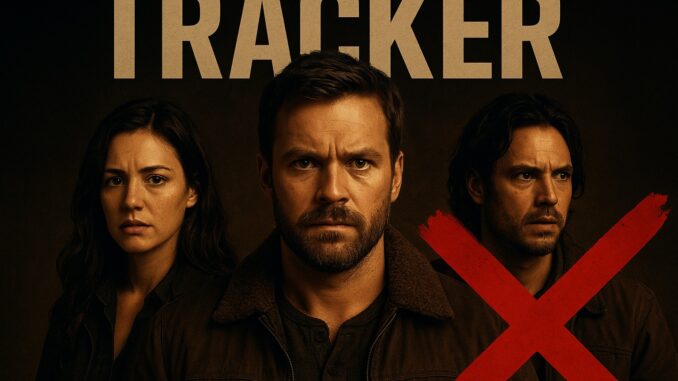
When Tracker returns with season 3, its cast will look a lot different, and that’s because the show seems to be sabotaging itself. The CBS action drama, created by Ben H. Winters, is based on Jeffery Deaver’s book, The Never Game, and follows Justin Hartley’s Colter Shaw. Colter is a survivalist who finds people for a living, but he doesn’t do it alone.
When Tracker returns with season 3, its cast will look a lot different, and that’s because the show seems to be sabotaging itself. The CBS action drama, created by Ben H. Winters, is based on Jeffery Deaver’s book, The Never Game, and follows Justin Hartley’s Colter Shaw. Colter is a survivalist who finds people for a living, but he doesn’t do it alone.
In Tracker season 1, Teddi and Velma Bruin assisted Hartley’s character by finding cases for him and researching anything he needed while on the job. Meanwhile, Bobby Hexley was Colter’s hacker, and Reenie Greene was his lawyer (and love interest). However, Teddi left Tracker after season 1, and now, two more characters are set to join her at the beginning of season 3.
What happens when a favorite show makes a gamble that might cost it more than it gains? Tracker Season 3 appears to be doing just that—letting go of two key characters to focus on just one. At first glance, it might feel like a bold storytelling strategy. But after peeling back the layers, it becomes clear that this decision risks undermining everything that made the show compelling in the first place.
In this article, we’re going to explore why this move feels dangerous, what the show risks losing, and how it could rebound—if it chooses to face the truth. Buckle up; it’s going to be a wild ride through character arcs, fan loyalty, thematic balance, and narrative integrity.
1. What’s the Big Shift in Season 3?
Season 3 of Tracker has made a bold pivot. Two previously central characters are being written out or marginalized, and the narrative is shifting its weight onto a single character arc. The focus is no longer shared; it’s consolidated. While focusing can sharpen storytelling, losing characters who carried emotional weight can hollow out a show’s heart.
2. Why These Two Characters Mattered
2.1 Emotional Anchors
These two were more than just plot devices. They gave fans someone to root for. They were vulnerabilities, strengths, contradictions—all the things that make fictional people feel like friends.
2.2 Driving the Subplots
They didn’t just exist; they pushed the subplots forward: into moral dilemmas, into world-building, into stakes that impacted more than just the protagonist. Their absence threatens to collapse threads built over previous seasons.
3. The One Character They’re Betting On
The show appears to be doubling down on one central figure—perhaps the protagonist, or a newly elevated character. This character is getting the spotlight: more screen time, more emotional weight, more of the narrative’s turning points. It’s like the writers are saying, “Forget ensemble; this person is the story now.”
4. Sacrificing Depth for Focus: The Risks
4.1 Overburdening a Single Arc
Putting too much on one character risks overexposure. Can one person carry all emotional, thematic, and plot responsibilities without making the story feel repetitive or shallow?
4.2 Loss of Variety and Contrast
The show loses contrasting voices. Two characters often provide contrast—morals, worldviews, humor, tragedy. Without that, the narrative can become monolithic, boring, or predictable.
5. Fan Backlash & Expectations
5.1 Emotional Attachment
Fans form attachments over time. When beloved characters are sidelined or removed, fans feel betrayed. It’s not just about the story—it’s about connection.
5.2 Social Media Outcry
We’ve already seen forums, Reddit, Twitter lighting up. Some spoilers or leaks might even fan the flame more. The perception that producers think fans won’t notice this trade-off is risky.
6. Narrative Imbalance: What Happens When Stories Lean Too Hard
6.1 Pacing Problems
Everything becomes about that one character’s arc—leading, perhaps, to slow moments, or contrived plot devices needed only to spotlight them.
6.2 Secondary Arcs Die
Without those two characters to support side plots, the secondary stories either die or feel forced. The richness of world-building and emotional layering suffers.
7. Thematic Fallout: What Gets Lost
Themes like sacrifice, teamwork, loyalty, ambiguity, or redemption often depend on multiple voices. Losing two characters might mean losing those themes or diluting them.
8. Opportunity Cost: What We’re Not Seeing
What else could the show be doing with its time and energy?
-
Deepening backstories of supporting cast
-
Exploring side quests or moral grey zones
-
Allowing tension and conflict to brew naturally
-
Giving space to unexpected character growth
9. When One Character Isn’t Enough
Even the strongest protagonists benefit from contrast. Think of Sherlock and Watson, Tony Stark and Pepper/Happy/others, Elsa and Anna. Characters don’t exist in vacuums—they are shaped by relationships.
10. What Other Shows Teach Us
10.1 Examples of Successful Ensemble Casts
Shows like Game of Thrones, Stranger Things or The Wire balance dozens of voices—and that’s what builds massive stakes and emotional investment.
10.2 When Singular Focus Succeeds
Some shows do pull off centering mostly on one character—but they usually have strong supporting roles, intermittent diversions, and they build tension outside the main arc.
11. How Tracker Could Still Course Correct
11.1 Bring Back or Reintegrate the Two Lost Characters
Even limited screen time or cameo appearances can calm fan frustration and preserve thematic texture.
11.2 Diversify Perspective
Alternate POV episodes, flashbacks, or subplot tie-ins can help broaden the world and share emotional load.
11.3 Raise Stakes Through Ensemble Conflict
Having multiple characters invested in the outcome increases tension. It’s more suspenseful when more than one person’s fate is on the line.
12. Strength in Ensemble vs. Lone Hero
An ensemble cast gives layers; it offers perspective. A lone hero narrative must rely on that hero’s internal depth, which can feel isolating or repetitive without external resistance or allies.
13. The Role of Supporting Characters
Supporting characters aren’t “extras”—they hold up mirrors to protagonists, reveal flaws, and create empathy. Removing them empties the emotional landscape.
14. Balancing Character Arcs: A Guide
-
Foil and contrast: Keep at least one character that challenges or grounds the protagonist.
-
Shared burden: Distribute emotional beats—don’t force one person to absorb all conflict and growth.
-
Multiple perspectives: Rotate focus so viewers don’t feel stuck.
-
Natural exit strategies: If a character must leave, do it with respect and narrative logic, not for shock alone.

15. Final Thoughts: Is Redemption Possible?
Yes. Tracker Season 3 might be making a risky bet by sacrificing two characters to elevate one, but redemption lies in acknowledging what’s at stake—and responding to it. If the writers listen to fan feedback, reintegrate emotional threads, and ensure the show doesn’t flatten its story, there’s room to steer things back. But make no mistake: what’s done is noticed.
Conclusion
Sacrificing two major characters for one might seem clever—a way to sharpen focus, to double down on intensity. But in doing so, Tracker Season 3 risks losing what made it rich: the ensemble emotional gravity, the multiple perspectives, the thematic contrasts. Fans aren’t just watching a story; they’re investing in relationships, character chemistry, and the tapestry that connects them all.
If Tracker wants to survive—and thrive—it needs to remember that sometimes more characters isn’t crowding the narrative; it’s building its depth, its heart, its capacity to move us. Otherwise, the show might end up sabotaging everything by narrowing the scope too far.
